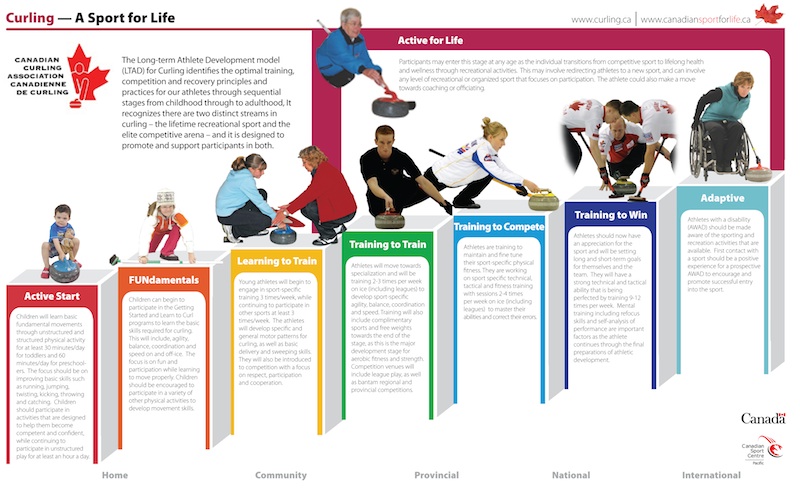Long-Term Athlete Development for Curling in Canada
Here’s an interesting fact for the curler who dreams of hoisting a championship trophy or showing off an Olympic medal: research shows that a high-performance curler should ideally be identified and begin the long process towards specialization between the ages of 13 and 15.
Does that seem young? According to research compiled by the authors of Curling for Life, a publication developed by members of the Canadian Curling Association’s high-performance coaching team, excellence does start young. But happily for the rest of us, the sport includes ample opportunities for curlers of any age, ability and level of participation.
 In a nutshell, that’s what the Long-Term Athlete Development (LTAD) program is all about. On a national scale, LTAD provides Canadian coaches and athletes in all sports a system for developing life-long physical activity and, where appropriate, excellence.
In curling, LTAD means ensuring that athletes experience the sport at whatever level fits his or her interest, ability and goals – and that coaches identify and develop those athletes who have the potential to reach the top levels of competition.
Canada considers itself a leading nation in the sport, but Canadian teams have seen the competition level rise. Teams from previously non-curling nations such as China and South Korea have burst on the international scene and won championships, even though their athletes have not come to the sport through the “curling club” culture so familiar to Canadians.
“Promoting excellence alongside recreation is important,” say the authors of Curling for Life. “While these two groups may experience a similar initial introduction to curling, at some point competitive curling athletes will emerge who wish to pursue the most elite levels of competition. The Curling LTAD model will provide a framework that ensures promising curling athletes have the possibility to achieve their potential through systematic and logical development.”
Throughout the season, we’ll be visiting the LTAD program – talking to coaches and athletes; exploring issues such as education and the role of parents in the development of young athletes; reporting on developments in the program, including the process of identifying and supporting Athletes With A Disability (AWAD).
“Research points to 10 key factors that influence the development of athletes,” say the authors of Curling for Life. The first one is “fundamentals” – with the emphasis on FUN. The LTAD program for curling in Canada is focused on supporting curlers at all levels of participation in the sport, ensuring that the resources are available for those who want to play at the local club – or chase an Olympic gold medal.
Read the PDF version of Curling for Life: Long-Term Athlete Development for Curling in Canada.
For more information about the national Long-Term Athlete Development program, visit the website, Canadian Sport for Life.
In a nutshell, that’s what the Long-Term Athlete Development (LTAD) program is all about. On a national scale, LTAD provides Canadian coaches and athletes in all sports a system for developing life-long physical activity and, where appropriate, excellence.
In curling, LTAD means ensuring that athletes experience the sport at whatever level fits his or her interest, ability and goals – and that coaches identify and develop those athletes who have the potential to reach the top levels of competition.
Canada considers itself a leading nation in the sport, but Canadian teams have seen the competition level rise. Teams from previously non-curling nations such as China and South Korea have burst on the international scene and won championships, even though their athletes have not come to the sport through the “curling club” culture so familiar to Canadians.
“Promoting excellence alongside recreation is important,” say the authors of Curling for Life. “While these two groups may experience a similar initial introduction to curling, at some point competitive curling athletes will emerge who wish to pursue the most elite levels of competition. The Curling LTAD model will provide a framework that ensures promising curling athletes have the possibility to achieve their potential through systematic and logical development.”
Throughout the season, we’ll be visiting the LTAD program – talking to coaches and athletes; exploring issues such as education and the role of parents in the development of young athletes; reporting on developments in the program, including the process of identifying and supporting Athletes With A Disability (AWAD).
“Research points to 10 key factors that influence the development of athletes,” say the authors of Curling for Life. The first one is “fundamentals” – with the emphasis on FUN. The LTAD program for curling in Canada is focused on supporting curlers at all levels of participation in the sport, ensuring that the resources are available for those who want to play at the local club – or chase an Olympic gold medal.
Read the PDF version of Curling for Life: Long-Term Athlete Development for Curling in Canada.
For more information about the national Long-Term Athlete Development program, visit the website, Canadian Sport for Life.

Elite curler Kaitlyn Lawes in action at the 2009 M&M Meat Shops Canadian Junior Curling Championships. (Photo Michael Burns)





